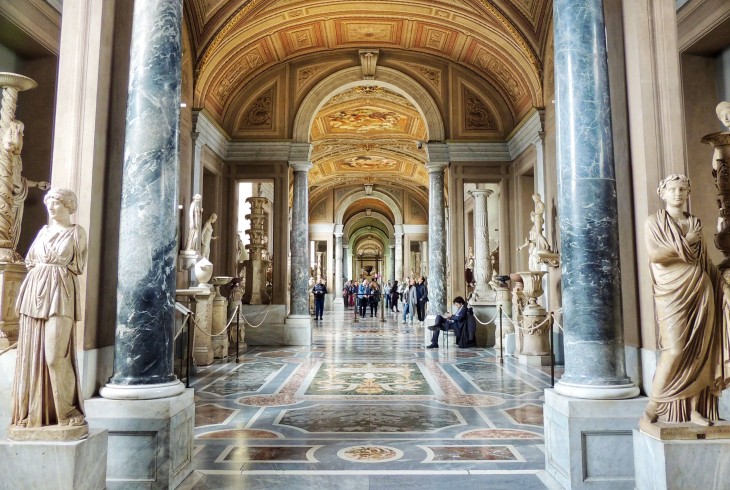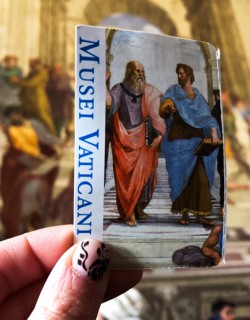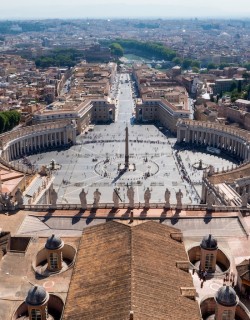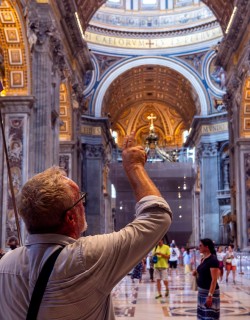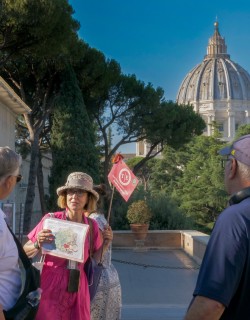A truly astounding treasure-trove of art, culture, history and spirituality, no visit to Rome is complete without a visit to the Vatican. The Vatican is much more than just the global headquarters of the Catholic church, and millions of visitors make their way to the world’s smallest state each year, whether they be devout pilgrims, art enthusiasts, history buffs or just incurably curious. If you’re coming to Rome, it’s a good bet that you’ll be joining them!
But before you go, you’ll want to learn a bit more about this place that has inspired such devotion over the centuries. In this week’s blog we’re charting the long and fascinating story of the Vatican, from its origins as a malaria-ridden hinterland in antiquity to the site of St. Peter’s martyrdom and subsequent rise to becoming the very epicenter of the Christian faith. Along the way we’ll discover how the Vatican became home to some of the greatest artistic masterpieces ever created - from Michelangelo’s Sistine Chapel to Raphael’s era-defining frescoes, ancient sculptures and much more - masterpieces that you can see for yourselves when visiting the Vatican Museums.
Read on to discover everything you need to know about the history of the Vatican!
Foundations: The Vatican Hill in Ancient Rome

Although the Vatican is indelibly associated with the Catholic church today, the area wasn’t always a site of Christian worship. In antiquity, this hill and plain overlooking the western bank of the Tiber River, known as the Ager Vaticanus, was something of a backwater far from the heart of Rome, flood-prone and unhealthy. By the early imperial period the area was being used for chariot maneuvers, culminating in the construction of a purpose-built stadium, the so-called Circus of Nero (which was actually built by Nero’s predecessor Caligula). It’s here that things get interesting.
In 64 AD, a devastating fire swept through Rome, destroying much of the city. Popular legend recounts how Nero fiddled merrily as the city burned, but although that might be an embellishment, the emperor certainly did seek to shift the blame for the conflagration onto a suitable scapegoat. His attention landed on the upstart religious community known as the Christians, at this point a marginal sect in the varied sacred landscape of the Roman empire.
Nero had known and suspected Christians rounded up and cruelly executed during public games he staged in the circus on the Vatican hill. According to Christian hagiography, amongst the Christians crucified along the spine of the circus was Jesus’ now elderly right-hand man, Peter. The corpses were buried in a nearby necropolis, which soon became a site of devotion for the growing Christian faithful.
The Rise of St. Peter’s
Nero’s circus was abandoned sometime in the second century AD, and nothing much happened again until the year 318, in the aftermath of a seismic event that would change the course of Western history forever. This was the conversion of the Emperor Constantine to Christianity after his victory at the Milvian Bridge in 312. After legalizing Christianity, one of the Emperor’s first acts was to commission a church to be built on the site of the abandoned circus - and St. Peter’s supposed final resting place.
From the outset, St. Peter’s was intended to be one of the most important sites of worship for the faith. The church, designed according to the principles of ancient meeting halls known as basilicas, was over 100 meters long and could hold up to 4,000 people. The church’s great size, fabulous architecture and sacred remains meant that it soon became an important site of pilgrimage and one of the most famous places in the Christian world.
In the 5th century, Pope Symmachus constructed a fortified palace near to St. Peter’s. The Vatican Apostolic Palace was expanded by Popes Eugene III and Innocent III in the 12th century. This was never, however, where the popes resided, and was instead intended to be used for brief excursions or as an impregnable hideout when the political climate in Rome became unstable. The permanent papal residence was instead located in an ancient palace across town at San Giovanni in Laterano - the official cathedral of Rome.
Learn more about the history of St. Peter's here with our in-depth guide.
The Borgo: Medieval Rome’s City Within a City
As the Roman church grew in power and prestige, the previously undeveloped area around St. Peter’s transformed into a bustling residential and commercial district that catered to the various prelates and functionaries that lived and worked at the Vatican’s Apostolic Palace. This area, known as the Borgo, also served the increasing number of pilgrims that made their way to Rome to pay their respects at St. Peter’s tomb, and by the Middle Ages was home to a vast array of hostelries, taverns and markets.
After a devastating Saracen raid damaged the Borgo and St. Peter’s in the year 846, Pope Leo IV resolved to bolster the area’s defenses by building a high wall all around the area. The so-called Leonine wall survives to this day, and marked the boundaries of Vatican control for centuries.
The Renaissance Miracle: Art, Architecture, and Power
The later Middle Ages was a very traumatic time for the church and for the city of Rome, culminating in the flight of the Pope to the French city of Avignon in 1309. The Papal palaces at the Vatican and the Lateran lay abandoned for the next 70 years. When the popes returned to Rome the following century, they focused on restoring the city’s infrastructure and developing the Vatican in particular. Pope Nicholas V built a grand new edifice over the old Vatican Apostolic palace, ordering over 2,000 cartloads of marble to be stripped from the Colosseum to aid in the construction and hiring Fra Angelico to fresco a magnificent new private chapel. Finally, the Vatican was to become the official residence of the Papacy.
Under the patronage of a series of wealthy and art-obsessed Popes, the Vatican palace became one of the world’s most incredible depositories of artistic masterpieces over the following centuries. Sixtus IV had a massive new chapel built in the 1470s, the Sistine Chapel, bringing the finest Florentine painters to paint its massive walls with biblical stories.
Not to be outdone, the Borgia Pope Alexander VI commissioned Pinturicchio to fresco his private suite of apartments here in the 1490s, only to be outstripped by his successors Julius II and Leo X, who engaged the services of Raphael to create what are known today as the Raphael Rooms just a decade later - an extraordinary series of rooms decorated with masterful frescoes including the School of Athens.
Julius also called on Michelangelo to fresco the ceiling of the Sistine Chapel, possibly the finest achievement in the history of Western Art, as well as gathering together a jaw-dropping collection of ancient sculptures which he displayed in a sculpture garden designed by Donato Bramante known as the Octagonal Courtyard - the original kernel of the Vatican Museums.
The Establishment of the Vatican Museums
The Vatican Museums as we know them today were first founded under the papacy of Clement XIV in the middle of the 18th century, and were established to display the extensive papal collection of antiquities begun by Julius II. The new museum was soon expanded by Clement’s successor Pius VI, and so this part of the complex is known as the Pio-Clementino museum. The renowned Neoclassical sculptor and architect Antonio Canova added the Chiaramonti sculpture gallery in the 19th century, which incorporates Bramante’s earlier Belvedere Palace.
New additions to the public areas of the museums came thick and fast over the 19th and 20th centuries, including the fabulous Etruscan Museum, the Egyptian Museum and the Pinacoteca, or Painting Gallery - home to extraordinary masterpieces by Raphael, Caravaggio and Leonardo da Vinci amongst others.
The Lateran Treaty and the Modern Vatican City
For centuries, the powerful Vatican presided over the vast Papal States, a great swathe of Italy that included Rome and the surrounding territory. Its influence dramatically declined as the 19th century wore on, however, as new political movements in Italy sought to break the feudal hegemony of traditional ruling classes. During the Risorgimento period, Italian revolutionary leaders sought to unify Italy into a modern, egalitarian nation state freed from the influence of the church.
Finally, in 1870 the newly established Kingdom of Italy annexed Rome, completing the process of national unification. This power of the Papal States was shattered; Pope Pius IX retreated into the Vatican, declaring himself a "prisoner" in protest of the loss of his empire. In 1929, the Lateran Treaty, agreed between the Pope and Mussolini’s government, officially established Vatican City as an independent sovereign state. Today, the Vatican City is the world’s smallest nation. Thankfully, however, you won’t even notice that you’re crossing a national border when you pass from Italian territory to the Vatican - as you must when you take a tour of the Vatican Museums - no passports required!
Now that you know all about the history of the Vatican, you’re ready to visit yourself. Through Eternity Tours offer a range of guided tours of St. Peter’s and the Vatican museums – join us and experience their splendor in company of our friendly expert guides!
MORE GREAT CONTENT FROM THE BLOG:
- The Best Vatican Tours to Take in 2024
- A Pilgrim and Tourists Guide to Jubilee 2025
- How to Climb the Dome of St. Peter's Basilica
- 7 Things You Need to See in St. Peter's Basilica
- Art and Faith in the Vatican: The History of St. Peter's Basilica
- Visiting St Peters and the Vatican Museums: A Practical Guide
- A Guide to the Vatican Gardens
